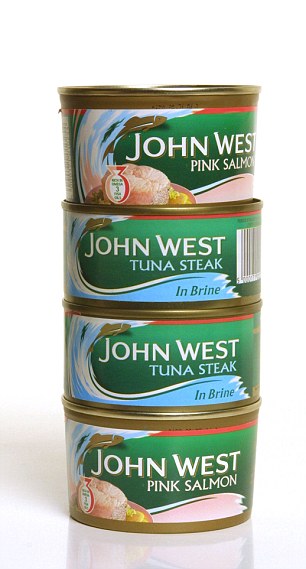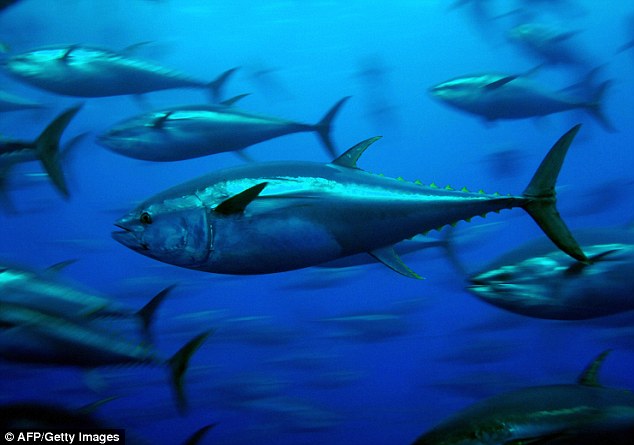
Under threat: Playful bottlenose dolphins seem like happier, carefree versions of ourselves, but are dying torturous deaths
How thousands of dolphins die for your cheap tuna sarnie: 98% of canned fish sold by John West are caught by methods which indiscriminately kill other marine life
By PHILIP HOARE FOR THE DAILY MAIL
PUBLISHED: 02:01, 15 October 2015 | UPDATED: 02:03, 15 October 2015
They are perhaps the most intelligent species on earth after humans. And they are dying torturous deaths to fill our lunchtime sandwiches.
A terrifying new report has found that 98 per cent of canned fish sold by Britain’s best-known purveyors, John West, are caught by methods which indiscriminately kill other marine life — including dolphins.
This is despite a claim from the company that its entire output would be sustainably caught by 2016. Not only that, it emerged this week that John West’s claims that the contents of its cans are ‘100 per cent traceable’ is false. The company has a label on its cans saying that customers can use its website to track where the tuna in each can came from.

Under threat: Playful bottlenose dolphins seem like happier, carefree
versions of ourselves, but are dying torturous deaths
But the website does not allow shoppers to trace tuna from Thailand — which has been warned with a ‘yellow card’ by the European Commission over illegal fishing activity — even though cans of John West tuna from Thailand are on sale here.
Ariana Densham, oceans campaigner at Greenpeace UK, is scathing. ‘It’s clear John West has no intention of keeping its sustainability promise,’ she says.
‘A pathetic two per cent of its tuna is caught in a way which minimises harm to other marine life.’
Most supermarkets try to ensure that their own-brand tuna is caught using the truly dolphin-friendly, traditional pole-and-line method where fishermen catch tuna one by one with a pole, line and hook, ensuring that no other marine life is harmed — known as bycatch in the industry — in the process.
Stores such as Waitrose, M&S, Sainsbury’s, Tesco, Aldi, Asda, Morrisons and the Co-op sell 100 per cent sustainable tuna under their own-brand labels.
In comparison, John West’s performance is truly appalling. A spokesman insists, however, that: ‘John West is fully committed to the protection of the marine environment and to sustainable sourcing.
‘Our overarching sustainability promise has not changed . . . we believe our commitments are best achieved by employing a number of practices and innovations . . . to minimise bycatch, protect stock levels, preserve oceans, improve working conditions and ensure safe and legal practices.’

John West are using methods which indiscriminately kill other marine life - including dolphins - to catch tuna
He adds feebly: ‘We have found it extremely difficult to increase the proportion of John West pole-and-line tuna that we can provide at a price that consumers would be willing to pay.’ So, according to John West, it’s our fault that not only dolphins but sharks, turtles, small whales, rays and God knows what else are dying in their thousands!
If the supermarkets can sell sustainable tuna, why can’t John West? And why don’t those supermarkets — which profess at every turn to care for the environment and sustainability — refuse to stock John West products until they are sustainable?
The hypocrisy is breathtaking — and the cruelty and suffering unimaginable. The Whale And Dolphin Conservation charity estimates that up to 300,000 dolphins die in nets each year.
As Susan Casey, author of a disturbing new book on the way we treat dolphins, says, there are many ‘piratical’ fishing operators, ‘none of whom give a damn about them’.
Dolphins feed on the same prey as tuna, and commonly swim alongside them. In some cases, fishermen even follow them to find the fish. The result is that, when nets are used, dolphins are often swept up as well.
Helicopters and speedboats are used to spot shoals of tuna, and huge nets are suspended in the sea like a wall to catch them — along with everything else. Another gruesome method is the use of so-called Fish Aggravating Devices — tethered buoys or large, raft-like objects in the sea, which attract small fish to the area.
Vast nets the size of football pitches are placed below these devices, and are drawn up when the fish have congregated. It is brutally indiscriminate. I saw this in operation in Haiti in the Caribbean earlier this year, and dived down to inspect one of the chains tethered to the buoy at the surface.
The chain plummeted 3,000ft to the sea bed, and I watched schools of small, brightly-coloured fish gather around the line, circling endlessly at each others’ tails in the warm, vivid blue water.
In due course, these little fish attract bigger fish, like tuna, marlin and mahi-mahi, which fed on them in turn. It’s this concentration of these valuable, oily, meaty fish which the fishing operators seek to catch in their huge nets.
Over the years, the nets have seen the deaths of millions of dolphins, which, as mammals and air-breathers like ourselves, drown when caught this way. Worse still is the sight of these beautiful creatures being mangled by the winches as the nets are hauled up.
It is an irony that tuna is promoted as a healthy food when our hunger for it creates such a trail of destruction. Any tuna company found using these methods, setting its nets around dolphins, is forbidden from using the dolphin-friendly symbol on its product.
Most supermarkets try to ensure that their own-brand tuna is caught using the truly dolphin-friendly, traditional pole-and-line method where fishermen catch tuna one by one with a pole, line and hook
But some companies get round it, claiming their methods are sustainable even though they use nets. They argue that they haul in the nets in a way which allows the dolphins to escape, assisted by fishermen who jump into the water to herd them out. But this doesn’t cut much ice with the renowned marine biologist and conservationist, Professor Callum Roberts of the University of York, who is highly sceptical about claims of sustainability used by these big companies.
‘You should know that they are a little misleading,’ he says with some understatement.
Freeing dolphins certainly seems to be an act of humanity, he explains. But in fact, the stress on the animals is immense.
The Humane Society estimates that as many as three million dolphins each year are ‘chased, traumatised and injured by encirclement’ during fishing operations.
In at least two species, reproductive rates are down, says Prof Roberts, ‘which can be attributed to stress from near-death experiences at the hands of tuna fishers’.
Pods of dolphins will vocalise their distress, sending out high-pitched whistles and human-sounding cries as they are caught. ‘Calves may be separated from their mother in the confusion,’ Prof Roberts adds.
The hypocrisy is breathtaking — and the cruelty and suffering unimaginable
The fact is that not all dolphin-friendly claims can be trusted. As Sarah Dolman, of the Whale And Dolphin Conservation charity, says: ‘Pole-and-line is the only way to guarantee no “bycatch”.’
Amazingly, she adds: ‘There is no legislation behind the labelling, and no consistency in the process. As a result, some “dolphin friendly” labels allow “limited” killing of dolphins.’
This is an extraordinary notion — like offering a vegetarian a salad with a little bit of bacon in it. And it should be enough to make any shopper put that tin back on the shelf.
Yet inevitably, the fishing industry and retailers see the label as a marketing tool. And in this there is another deception — particularly when it comes to tuna in the UK.
Quentin Hanich, from the Australian National Centre For Ocean Resources aAnd Security, observes that most tins of tuna sold in the UK contain skipjack tuna from the Atlantic, which doesn’t usually swim with dolphins.
This means that it may be genuinely ‘dolphin-friendly’, even if it is fished using unsustainable practices which kill other species.
‘Consumers need labels that address the fishing impacts on other species and on the broader environment,’ says Hanich. ‘It isn’t enough just to know your tuna is “dolphin-friendly”.’

Helicopters and speedboats are used to spot shoals of tuna, and huge nets are suspended in the sea like a wall to catch them
And come to think of it, tuna itself is under such pressure that three species are endangered, and three vulnerable to extinction.
I’ve seen and swum with many hundreds of dolphins in 15 years’ of research. Who could fail to feel their pulse quicken when bottlenose dolphins hove into view and begin to ride at the bow of a boat?
Dolphins endear themselves to us because they seem like happier, carefree versions of ourselves.
But tuna, too, are beautiful creatures. I’ve seen yellowfin tuna leaping out of the Indian Ocean, the sun glinting silver on their sides, their exquisite spiny fins like some exotic piece of baroque jewellery.
They can also reach an enormous size. Bluefin tuna weighing 800lb have been caught in the Atlantic. But will such giants, now facing extinction, become mythic catches of the past?
Don’t they deserve our respect? Unless we do something drastic about our wilful exploitation of the world’s oceans, that phrase ‘plenty more fish in the sea’, may come to haunt us.
Read more: http://www.dailymail.co.uk/sciencetech/article-3273398/How-thousands-dolphins-die-cheap-tuna-sarnie-98-canned-fish-sold-John-West-caught-methods-indiscriminately-kill-marine-life.html#ixzz3ofqs7Ozn
Follow us: @MailOnline
on Twitter | DailyMail
on Facebook